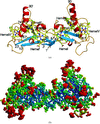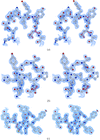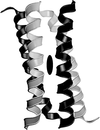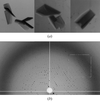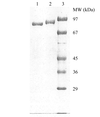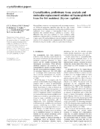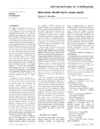issue contents
April 2003 issue

Cover illustration: The currently accepted fibre model structure for B-DNA shown using the ball-and-stick representation and coloured by nucleotide with a ribbon superposed on the backbone connecting the P atoms (p. 620).
editorial
Free 

topical reviews
This review provides a glossary of currently identified DNA structures and outlines the present understanding of DNA structure exactly 50 years after the original discovery of the structure of DNA by Watson and Crick. It also highlights the need for caution when assigning names to novel DNA polymorphs.
research papers
The structure of a thermostable family 11 xylanase from B. subtilis subspecies B230 is presented and the structure analysed. Possible means of improving the thermostability of this enzyme are suggested.
The 1.5 Å structure of the catalytic domain of the major cellulase of P. chrysosporium, Cel7D (CBH 58), gives new insights into the basis of enantioselectivity in this family of enzymes.
PDB reference: Cel7D catalytic domain, 1h46, r1h46sf
High-resolution refinement of dimeric cytochrome c3 and detailed sequence and structural comparison with all other known c3 domains are described.
PDB reference: cytochrome c3, 1gyo, r1gyosf
The structure determination of human dihydrofolate reductase as a binary complex with the potent N9—C10 reversed-bridge antifolate inhibitor 2,4-diamino-6-[N-(3′,4′,5′-trimethoxybenzyl)-N-methylamino]pyrido[2,3-d]pyrimidine is reported for two independent polymorphic rhombohedral R3 lattices.
A procedure is described for locating the anomalous scatterers in SAD and MAD cases.
The occupancy change of the double conformation of GluB13 characterizes a pH-dependent dynamic switching process. The occupancy of the sulfate ion decreases as the pH increases. Comparisons of the observed structure factors and structures indicate that the porcine insulin structure changes gradually as a function of pH.
The structure of the antibody Fv fragment 7E2 that is directed against the cytochrome c oxidase from Paracoccus denitrificans shows that variable domains have highly conserved solvent shells along their framework regions. The structure reveals local `breathing' inside the hydrophobic cores, a novel CDR-L3 loop conformation and peculiar differences in the VH/VL-pairing.
PDB reference: unliganded 7E2 Fv fragment, 1mqk, r1mqksf
SAD phasing based primarily on sulfur anomalous scattering measured in-house led to easily interpretable maps for five standard test proteins.
An analysis of heat transfer from protein crystals is used to prioritize experimental parameters affecting the success of low-temperature X-ray data-collection procedures and to evaluate methods for reducing crystal heating by X-ray absorption.
A stochastic multidimensional molecular-replacement method has successfully been applied to a 23-dimensional problem.
PDB reference: A31P Rop, 1gmg, r1gmgsf
crystallization papers
Crystals of the DNA methyltransferase HP1352 from H. pylori have been obtained and diffract to 2.5 Å resolution.
The Ni/Fe–S-dependent α2∊2 subcomponent of the acetyl-CoA decarbonylase/synthase from M. thermophila was purified and crystallized. The crystals were mounted in a capillary and diffracted to 4.0 Å resolution at room temperature using a synchrotron-radiation source.
The actin-binding domain of human α-actinin has been cloned, expressed and crystallized. Single-wavelength anomalous dispersion data were collected from microcrystals of selenomethionine-labelled protein using a microfocused synchrotron X-ray beam.
The copper-containing amine oxidase from bovine serum (BSAO) has been deglycosylated and crystallized. Crystals belong to space group P212121, with a dimer in the asymmetric unit.
AHP IX-bp, a new coagulation factor IX binding protein, was purified from the venom of A. halys Pallas and its biochemical properties were partially characterized. The crystals of AHP IX-bp at two different pH conditions were obtained and the X-ray diffraction data were collected and reduced respectively.
Ferredoxin obtained from M. laminosus has been purified and crystallized. The future-determined crystal structure is expected to provide valuable data on the factors inducing thermostability in proteins.
Two putative nudix hydrolases, DR1025 and DR0079, from the radioresistant bacterium D. radiodurans have been expressed, purified, crystallized and their diffraction data collected to 1.4 and 1.9 Å resolution, respectively. Anomalous diffraction data were measured to 1.8 Å resolution for an Sm3+ derivative of DR1025.
2-Hydroxybiphenyl 3-monooxygenase (HbpA) from P. azelaica HBP1 was crystallized as both native and selenomethionine-labelled protein (SeMet HbpA). From these crystals, diffraction data were collected to a resolution of 2.0 Å for native and 2.25 Å for SeMet HbpA.
Crystals of an endoxylanase inhibitor from Triticum aestivum L. have been prepared and proved to be suitable for successful structural analysis.
Recombinant Gly1ORF1 has been expressed, purified and crystallized. SeMet-substituted crystals were also prepared, aiming towards the three-dimensional structure solution via MAD methods.
Crystallization and X-ray diffraction analysis of the sensor domain of the HemAT aerotactic receptor
HemAT protein is responsible for sensing oxygen for Bacillus subtilis. The sensor domain of HemAT was cloned, expressed, crystallized and its structure is determined by a MAD method.
The crystallization and preliminary X-ray analysis of the major haemoglobin (BcHb-II) from the fish matrinxã (B. cephalus) is reported.
The crystallization and preliminary X-ray diffraction of EF0377 is reported.
The 14 kDa receiver domain of MicA response regulator from S. pneumoniae has been crystallized and its preliminary crystallographic data recorded.
Two homologous domains from a dinoflagellate luciferase responsible for seawater bioluminescence have been prepared and crystallized. Domain D2 crystallized in space group P212121 and diffracts to 2.8 Å on a rotating anode. Domain D3 crystals were grown in space group P212121 and diffract to 2.3 Å on a rotating anode.
short communications
The three-dimensional structure of the uncomplexed 20K endoglucanase from the thermophilic fungus M. albomyces is mostly similar to that of previously determined family 45 endoglucanases, except that the flexible loop between strands V and VI is well ordered. Thermophilic and mesophilic endoglucanases of this family can now be compared.
PDB reference: 20K endoglucanase, 1l8f, r1l8fsf
The efficiency of three commercially available crystallization screens was compared using 19 different proteins. The study identifies the most successful crystallization conditions in these screens and some general trends in the effectiveness of individual crystallization components.
Acceleration data registered onboard the ISS have been analysed in combination with observed (PPG)10 crystal motions and crystal quality.
international union of crystallography
Free 



 journal menu
journal menu















